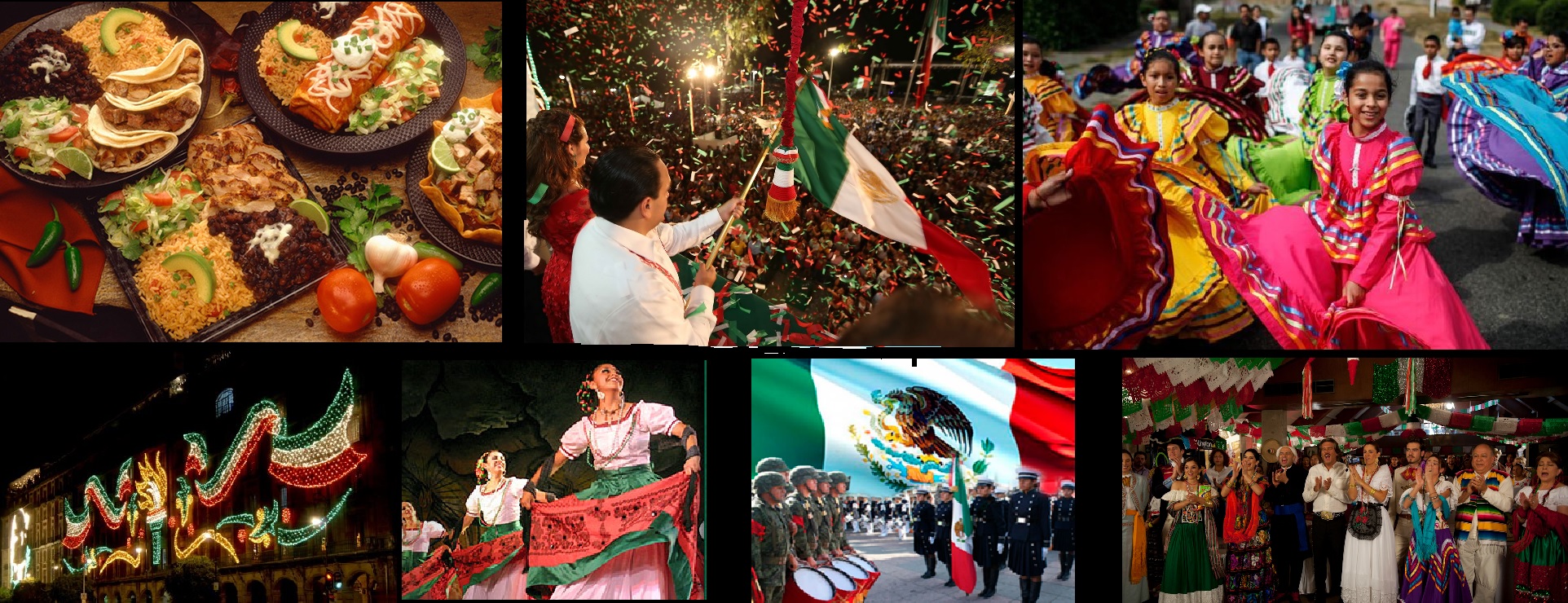Join us for the Annual Mexican Independence Day Celebration!
Sunday Sept. 15th, 2019
5:00 PM – 9:00 PM
California State University, San Bernardino
Meeting Centers Area - Patio
Cultural performances, Music, and a varied assortment of Mexican Foods will be sold on-site.
Students, Faculty, Staff and Community Welcome
Event is FREE - COMPLIMENTARY Parking in Lot D
El Grito De La Independecia Event Flyer - English Version | Spanish Version

On this day Mexicans all over the world celebrate Mexico’s independence from Spanish rule.
Mariachi bands, Folkloric dancers and local singers and musicians, and the Mexican Consulate will provide the traditional Independence presentation (Grito)
Food vendors will be on hand to provide great Mexican entrees.
Come join us for this family-friendly and educational evening, and anticipated yearly event for all to enjoy.
*Not to be confused with Cinco de Mayo, this austere re-enactment ceremony and civic act echoes the bells with which Father Hidalgo called the Mexican people to rebel and fight against Spanish dominance, to establish a new sovereign country.
At around eleven in the evening, the President of Mexico rings the bell of the National Palace in Mexico City. After the ringing of the bell, he repeats a cry of patriotism (Grito) with the names of the important heroes of the Mexican War of Independence who were there on that very historical moment included, and ending with the threefold shout of ¡Viva México! from the balcony of the palace to the assembled crowd in the Plaza de la Constitución, or Zócalo, one of the largest public plazas in the world.
In our local Independence Celebration, our own Mexican Consulate also re-enacts the same civic ceremony by ringing a bell and giving the traditional words, with the names of Mexican Independence heroes included, ending with the threefold shout of ¡Viva México!
In both cases, as world-wide, after each line the crowd responds in return by shouting ¡Viva! The bell rings for a second time, followed by the waving of the Mexican flag and the singing of the Mexican National Anthem.
Come join in this exciting traditional event with food, music, and live performances; -as well you will be able to watch the live-feed on the large projector screens of the re-enactments and celebrations from the Zócalo in Mexico City, as well as others all over the world.
Sponsors & Partners
- Latino Education & Advocacy Days (LEAD)
- Association of Latino Faculty, Staff & Students (ALFSS), CSUSB
- Liberal Studies Program, CSUSB
- Office of the Mexican Consulate, San Bernardino
- Associated Students Incorporated (ASI), CSUSB
- Santos Manuel Student Union - LatinX Center, CSUSB
- San Bernardino Mission Chapel / Santana Funeral Services
- San Bernardino City Unified School District
- Apoyo Financiero
- Office of the President & Cabinet, CSUSB
- Cardenas Markets
- College of Extended & Global Education, CSUSB
- Office of Catholic Schools, Diocese of San Bernardino
- Office of Undergraduate Studies, CSUSB
- Assemblymember Eloise Gómez Reyes, CA 47th Assembly District
- Gil Navarro, Non-Attorney Representative
- AT& T, Riverside/San Bernardino Counties
- San Bernardino County Superintendent of Schools
The CSUSB campus Meetings Center patio (formerly the “Commons”) transforms into a festive setting filled with unforgettable colorful Aztec and glamorous Ballet Folklorico dancing, live Mariachi music, food vendors, exhibits and displays, educational activity centers for the children, and very special live performances by great musical artists.
Witness the historical civic ceremony and emblematic re-creation of “El Grito de Independencia (de Dolores)” conducted on the balcony by the Consul General de Mexico, and in chorus by community and civic leaders, and elected officials!!! The Grito honors the traditional call to arms on the eve of Mexican Independence Day and is a massive, synchronized call that dates back to 1810 and the fight for Mexican Independence from Spanish rule.
Bring your own chairs or blanket and spread out on the lawn, or enjoy the lively family celebration from the patio seating provided. Our family-friendly, campus festival is an opportunity to experience a traditional and authentic fiesta.
Celebrate the richness, diversity, and significant contributions that Latinos have made to our past, present, and future. “Fiestas Patrias” commemorate 18 Latin American countries' independence from Spain, including Argentina, Belize, Bolivia, Brazil, Chile, Colombia, Costa Rica, Ecuador, El Salvador, Guatemala, Honduras, Mexico, Nicaragua, Panama, Paraguay, Peru, Uruguay and Venezuela.
*Some historical notes:
The first two, and most notable, countries in the Americas to gain independence were the United States (1776), led by General George Washington, and Haiti (1804), led by Toussaint L’Ouverture.
Other Latin American countries soon followed, with exceptions such as Cuba and Puerto Rico, embarking on their struggles for independence in the early nineteenth century.
It was in the early 1800s that with some help from the U.S. and France, the country started to plan its revolt. One of the principal leaders, Father Miguel Hidalgo, held a meeting at his church in Dolores, Guanajuato, Mexico,
ringing the bell on the night of September 15th, 1810 to call his congregation to mass. He urged them to fight, giving a speech that’s known as “El Grito de Dolores,” (“The Cry of Dolores).”
He cried “¡Viva México!” and “¡Viva la independencia!” — which means “May Mexico live on!” and “May independence live on!” —
during the speech, giving way to some of the country’s most famous battle cries. Mexican independence was achieved in 1821 following a long and bloody struggle.
Thus, yearly on Sept 15 & 16, Mexicans all over the world celebrate Mexico’s independence from Spanish rule.
The goals of the Mexican independence revolution were liberation from Spain, the end of slavery and the return of lands to the indigenous inhabitants.
California at the time was a northern province of Mexico. After the Independence Revolution, 'ranchos' (huge cattle ranches), soon and slowly emerged as the dominant institution of Mexican California;
and the most visible impact of Mexican independence was the secularization of the California missions. The missions lost their lands and much of their power.